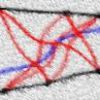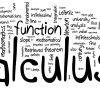 21
21okay pls tell teh mistake i'm making
the mass of the small Helicopter = 1/8 ( real helicopter)
Lift ∞ density of air * area of rotor
area of rotor of small one = 1/2(that of the real one )
Lift ∞ power of motor which gives P/4
i know i have mistake. pls find it
 1
1uh sorry, I did not think critically.
I think I am getting closer to the answer, wait for some time.
 71
71Yeh Helicopter dikhta kaisa hai.. koi kuch hints toh do.. Linear dimension matlab hi nai samjh aa raha!
 1
1It can be proved that the force of thrust is ÏAv2, where Ï is the density of air, A is the area swept by the blades (which creates the air column for required thrust) and v is its velocity.
This force of thrust balances the weight of the Heli., W
Initially,
P°=Fthrust*v
W=ÏAv2
I will use ~ for proportionality.
v~√W√A
v~√Volume√A
v~√L3√L2, where L is a linear dimension of Heli.
so v~√L
we have P=ÏAv3~L2L3/2=L7/2
so P ~ L7/2
New P = (0.5)3.5P°=0.0884P° (app.)
Edit: Ricky, you took away my 30 minutes :D
 1
1The required power for the hovering helicopter depends on the gravitational acceleration " g " , the linear size of the helicopter " L " , the average density of the helicopter " PHel. " and the density of air " PAir " .
It is reasonable to assume that the mechanical power needed depends only on these quantities and that the dependence is a relationship :
P ≈ g α L β ( PHel. ) γ ( PAir ) δ
Solving via dimensional analysis , we get -
β = 72
α = 32
γ + δ = 1
Using simple dimensional analysis we could find only the sum of the exponents " γ " and " δ " . However, it is clear that " P " can depend only on the product of the density of the Helicopter and " g " , because, when the Helicopter is hovering, the relevant quantity is not its inertial mass, but its weight .
Thus " γ " must be equal to " α " , so , " γ " = 32, i . e . , " δ " = - 12
Here , on the surface of the Earth, we can change only the size and density of the helicopter. Nevertheless, for a space mission using robot helicopters , we have to know how " P " depends on the gravitational acceleration and the atmospheric density of the target planet . That is why " P " must depend upon these quantities .
 1
1If you really want onto find out the dependence of power required for hovering, you have to dig very deep. There are many other quantities on which power output P can depend. For ex- P depends on the drag force of air, internal resistance of the engine etc etc. I don't think your 'reasonable assumption' is scientifically valid, when you ignore other factors.
Now to solve the problem, you don't need to worry about all those things as both the helis are exactly same in all aspects.
 1
1For ex- P depends on the drag force of air, internal resistance of the engine etc etc.
These things remain constant for a given situation .
A flaw in your solution - Firstly , the length of the blades is not the same as the Helicopter . Secondly , if I keep the area of the blades as constant , then your solution won't hold .
 1
1These things remain constant for a given situation .
For the given situation, do you think 'g', avg. density of the heli, density of air change?
Firstly , the length of the blades is not the same as the Helicopter
Agreed. So what?
Secondly , if I keep the area of the blades as constant , then your solution won't hold .
Does the question mention that the area of the blades is constant? Why would you keep it constant? When the linear dimensions are halved, each and every linear dimension - breadth,length etc is halved. You cannot keep the area constant.